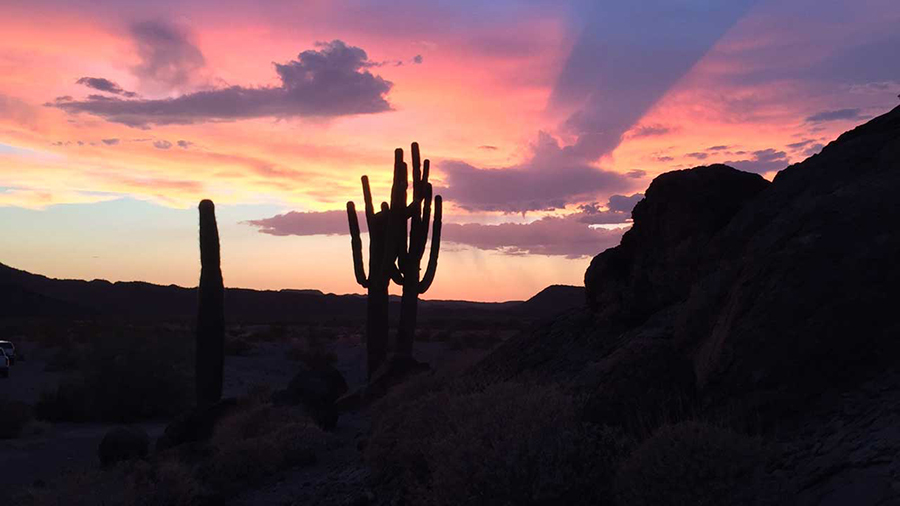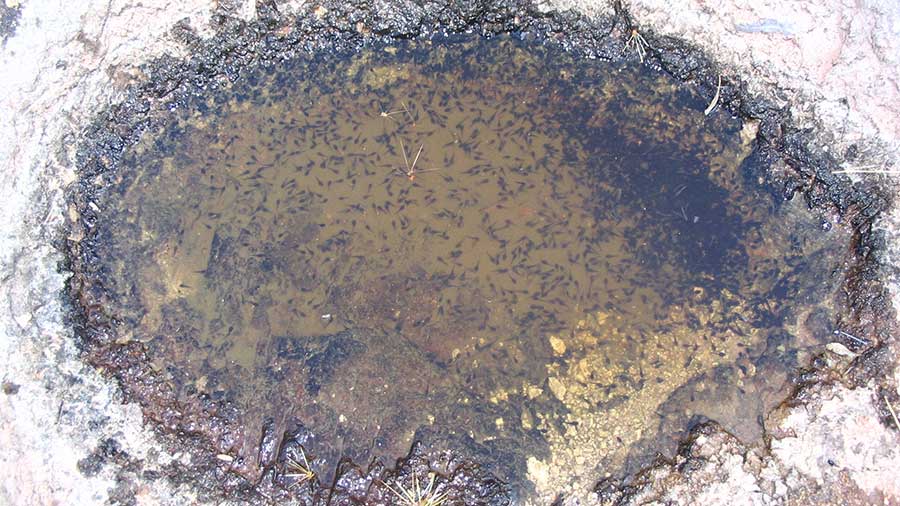Long-term Study Improves Wildlife Water Management in Arizona Desert
December 8, 2020 | By: Karen Michael
Texas Tech Researchers Study Desert Water, Wildlife Disease
Like West Texas, you can never tell when the rain might fall in the Sonoran Desert of Arizona.
Failing to be there for the rain could set back the collection of long-term data needed to make decisions about the management of desert ecosystems
Kerry Griffis-Kyle, associate professor in Texas Tech University's Department of Natural Resources Management, is studying desert water sites, both natural and manmade, and how we can better manage them to support desert wildlife. Her research examining water quality and disease is funded by the U.S. Department of Defense.
“You get this accumulation of organic matter over time, and it gets really nasty,” Griffis-Kyle said.

It isn't just that these water sites accumulate organic matter such as dead organisms and algae, she said. This organic material decomposes, causing ammonia concentrations to increase substantially. Ammonia is harmful to animals like amphibians that live in the water and can be harmful to mammals that drink the water, increasing dehydration and causing neurological problems.
Although organic matter accrues in all the water sites, the natural erosional pools in the bedrock, known as tinajas, at least get washed out during heavy rains. However, the summers are getting drier and the rains are fewer and further apart, so the tinajas don't always hold water for long. Manmade catchments are only cleaned if someone travels out to the site and cleans out the debris. However, water is delivered to these man-made sites when they dry, so the catchments are sometimes the only source of surface water for desert wildlife.
These isolated desert water sites may operate as “ecological traps” when organic matter accumulates. Ecological traps are attractive but poor-quality resources that hurt the wildlife more than they help. Griffis-Kyle is investigating these issues to better understand the impacts the increasingly poor water quality can have on wildlife and their ability to persist in this extreme desert habitat.

“We're working with the military on ways to better manage those waters to support wildlife populations,” Griffis-Kyle said.
Her work is already influencing wildlife water supplementation programs managed by state and other federal land managers, and it is making a difference. Because of the long-term data, Griffis-Kyle can compare water quality before and after management changes and has shown some improvement in quality.
But water quality may not be the only problem for wildlife at these sites. Because various wildlife species congregate at the waters, the sites may function as sites of transmission for parasites and pathogens.
One of these pathogens can get transferred at wetlands. Batrachochytrium dendrobatidis, the fungus that causes the amphibian chytrid disease, should not be an issue in this environment because of the intensely hot and dry conditions common in the Sonoran Desert.
“We found it down there on amphibians and in the water,” Griffis-Kyle said.
Now Griffis-Kyle and her collaborators, including Matt Barnes, an expert on environmental DNA at Texas Tech, are trying to figure out how the pathogen got there, where it came from, the impact it is having on local amphibian populations, and whether they can do anything to mitigate the impacts to Arizona amphibians.
While her research on water quality and disease has been focused on amphibians, the information and guidance she is providing has been used for improving desert water management for other wildlife, including large mammals like the Sonoran pronghorn and mule deer.
“The implications reach beyond a few species of frogs in the desert. Water quality has consequences all the way up the system,” Griffis-Kyle said.
The Department of Defense is more proactive than most other agencies in the management of wildlife and biodiversity, she said. “They want to be able to head off problems, so that they can continue doing what they need to do to support their mission. The information we provide and suggestions we make help guide their decisions about the management of their natural resources,” Griffis-Kyle said.
Yearly data help the military refine management based on current conditions, but “if you're trying to look at long-term trends and plan ahead, you need to have long-term data,” Griffis-Kyle said.
This is especially important when dealing with an environment that is changing beyond what has been seen in the past. Land managers have to plan water availability for wildlife and this requires predicting future conditions as the weather is becoming hotter with more droughts and shifting rainy seasons.
“Being able to keep track of how water availability and quality is changing, gives us the ability to make better predictions about future conditions and how to deal with those conditions. And doing a better job at predicting future conditions means that we can better support desert wildlife populations,” Griffis-Kyle said.
Because of the military's need for ongoing information, she said it was important that the research not be halted due to coronavirus. An unexpected consequence was that the field crew were more isolated from the spread of the disease than they would have been if they had remained in West Texas.
“Not many people are willing to brave the wilds of the Sonoran Desert in the intense summer heat,” she said.
Office of Research & Innovation
-
Address
Texas Tech University, 2500 Broadway, Box 41075 Lubbock, TX 79409 -
Phone
806.742.3905 -
Email
vpr.communications@ttu.edu
